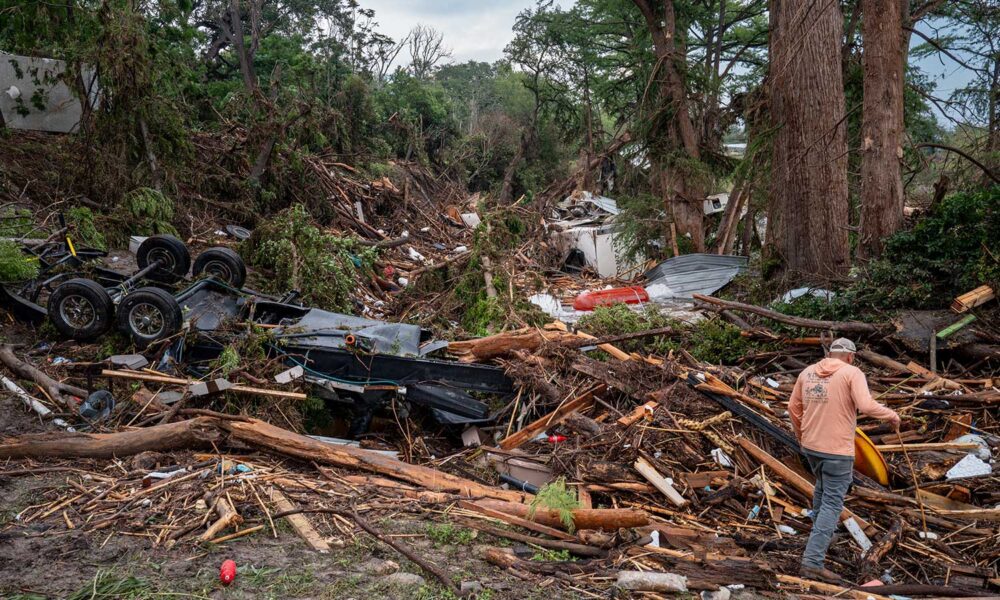We are all heartbroken at the unbearable tragedy that’s unfolding in Texas—so many precious lives lost in such a cataclysmic flash flood along the Guadalupe River around Kerrville. As families wait desperately for news of loved ones, the focus on rescue and recovery is paramount, with the hope that lives may still be saved. Disasters also require us to parse through the facts carefully, reject disinformation, and focus on what went wrong and how we can ensure we do better at keeping communities safe. This blogpost is a first attempt at capturing some of the major takeaways we see, and we will build on this going forward as more information becomes available.
One big takeaway
There is a lot to learn from this disaster, and one thing we simply cannot do is allow the Trump administration to continue to attack, defund, and dismantle the very agencies that help keep us safe and recover from disasters, including NOAA and FEMA. Quite the opposite: we need to ramp up investments in cutting-edge science and climate resilience to keep people safer as climate extremes intensify.
1. A terrible confluence of factors in “flash flood alley”
This region of Texas is notoriously prone to flash floods, and this particular event had the worst possible confluence of conditions. The remnants of Tropical Storm Barry, which made landfall in Mexico earlier in the week, and warmer-than-usual Gulf waters both contributed to more moisture in the air when it started raining. The area around Kerr County was also under severe to exceptional drought conditions which makes runoff and flash flooding more likely as the ground is less effective at absorbing water. This meant that 10-plus inches of rain fell to quickly run off into the river, contributing to a rapid rise in water levels. In addition to these meteorological factors, the worst of the flooding happened late at night when people were asleep, and it was a holiday weekend with lots of folks camping along the Guadalupe River. Cell phone alerts may not have reached some people in remote areas.
2. Made worse by climate change
Climate change is increasing the risk of these types of extreme precipitation events. For example, there has been a clear increase in higher rainfall intensity events for nearby Austin, Texas. According to the Fifth National Climate Assessment (No longer available on the USGCRP website because of the Trump administration, but archived here), the Texas region has experienced a 21% increase in total precipitation in the heaviest rainfall days since the 1950s.

3. The NWS did its job
The NWS office in Austin/San Antonio flagged the risks early and repeatedly through multiple alerts, but it’s clear that those alerts didn’t reach people in time with the appropriate level of urgency. Well-documented reports show that 12 hours before the rainfall began, the NWS issued a flood watch for the Central Texas region, and by 6:10 pm CDT, the Weather Prediction Center warned of the possibility of flash flooding overnight. The rain began locally in Kerr County, where Camp Mystic is located, around 1:00 am CDT, and a “considerable” flash flood warning was issued by the National Weather Service (NWS) by 1:14 am CDT. USGS river gauges along the Guadalupe River began to spike, some showing water levels rising by tens of feet in less than an hour, around 3:30 am CDT.
4. And the NWS is under duress
During this flash flooding event in Central Texas, the local NWS offices in San Angelo and nearby San Antonio were together reportedly lacking several staff, including a senior hydrologist, staff forecaster and meteorologist in charge, a warning coordination meteorologist and a science officer. These roles are an important part of any NWS office: the hydrologist, for example, helps to monitor the river gauges. Questions remain whether these vacancies contributed to a lack of timely coordination with local emergency officials. While the forecasts may have been solid, not having local knowledgeable experts to communicate the risks to local officials and translate them in actionable ways may have contributed to some of the challenges.
5. A critical “last mile” emergency alert breakdown
Every level of government has a critical role to play in preventing, predicting, and responding to emergencies. In this case, it seems that the “last mile” emergency alerts and coordination were clearly lacking. Beyond the NWS, local officials did not act expeditiously enough to communicate risks or evacuate people from harm’s way. Despite the region’s history of floods, there isn’t a local early warning alarm system, something the county has long needed.
6. Dismantling of federal systems that keep us safe
Science-based tools and forecasts are critical to keeping people safe in the face of climate-change–fueled extreme weather, yet the Trump administration is hell-bent on dismantling NOAA and slashing budgets for NOAA, USGS, and FEMA’s pre-disaster resilience programs. We know the risks of these events are worsening and our best opportunity to keep people safe is by continuing to invest in the science and modeling tools to improve forecasts of complex weather disasters. DHS secretary Kristi Noem’s remarks about “working to upgrade technology” during a post-disaster media briefing are particularly galling when in fact this administration is taking a hatchet to NOAA’s science, data, and modeling capabilities.
7. Communities need stronger, not weaker, federal support
States and local communities simply CANNOT cope with this scale of disaster and need federal government support, which is why it’s so important that President Trump has quickly approved a major disaster declaration and activated FEMA federal disaster assistance. Impacted residents can already start applying for disaster assistance. On its own, Kerr County would hardly be able to gather up funding to cope with the costs of the large rescue, response, and short-term recovery operations. This exposes why the administration’s politicization of disaster aid and threats to dismantle and get rid of FEMA while pushing the burden of disaster response and recovery onto states is reckless and cruel.
Congress must defend NOAA and FEMA
The Texas flash flood is a still-unfolding horrific tragedy, with many complexities, and there will be much more information to learn from in the days to come. We’ve learned a lot and benefitted from excellent information being shared by scientists and meteorologists in these past few days, including Daniel Swain, John Morales, Marshall Shepard, the Balanced Weather substack and Matt Lanza.
We urge Congress to stand up to the Trump administration’s attacks on federal government agencies and science, including NOAA and FEMA, whose value is especially evident in the face of these kinds of extreme disasters. We also need resources for better emergency coordination from the federal to the local level. Climate change will make these kinds of extreme events more common and intense, and people’s lives are at stake.
If you are able to donate, please go here for resources on how you can help the victims of this disaster.
Other resources:

